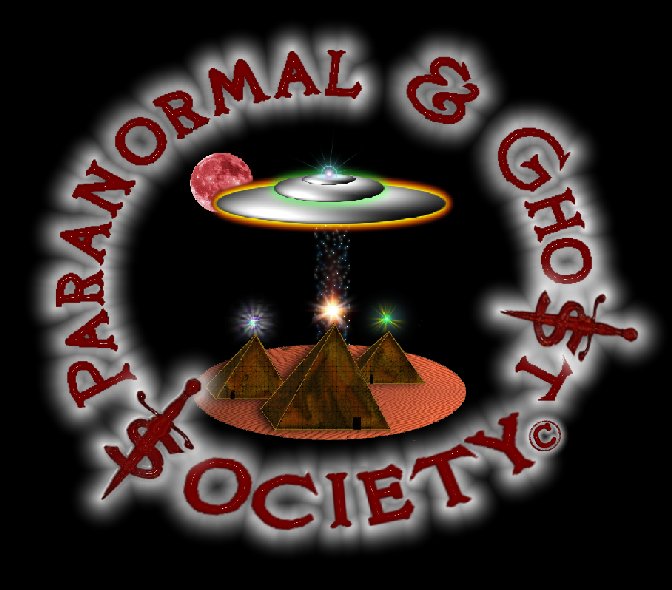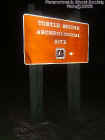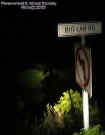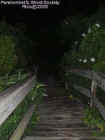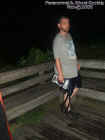|
"We Journeyed Throughout The Night Overcoming All Trials As They Watched In Fear From Afar As We Unraveled Their Secrets" AngelOfThyNight
|
||
|
Turtle Mound is part of the Cape Canaveral Sea
Shore dating all the way back to 2,000 BC inhabited by the Timucuan Indian
Tribe. Since we investigated Turtle Mound our first investigation took a
turn into investigating a very large area of the cape known also as Space
Coast. It is called this cause Kennedy Space Center is based along the
coast where NASA launches its shuttles and rockets from.
The Cape Canaveral Seashore is full of many different Indian mounds, sand dunes, wildlife, islands, swamps, hammocks, pine flatwoods forest, lagoons, salt marshes, and many different forms of plant life. When I chose to investigate this area it was because I knew that not only was it a place with alot of history it also is a place that anything can hide. When I say anything I mean perhaps something Cryptid. But these islands are not just known for Kennedy Space Center but for Mosquito Lagoon. Imagine walking in this place into a storm of mosquito's flying past you like a blizzard by the 1000s. So this is a very intense place full of danger and adventure. I believe that even the gators here are quite abundant and maybe even some of the largest in the state. Turtle Mound is one the biggest Indian mound in the country and its the tallest one as well. It covers 600 feet of Indian River shoreline, 35,000 cubic yards of oyster shell, and 50 feet in height. It use to be at one time 75 feet in height but erosion has deteriorated its size. The mound is visible for miles offshore which was a tool used for navigation when the Spanish Explored Florida's Coast. The entire mound is covered with scrub bushes and trees. When the Timucuan's inhabited the area the Cacique known as the Chief had a hut on top of it where he could look out into the ocean. One can just imagine the scattered Indian village around this jungle like setting where they would bury there dead by wrapping them layer by layer within the mound. So you can see why we chose to investigate such a prehistoric area. When the Spanish Explorer visited the Cape in 1605 by the name of Alvaro Mexia and called the site Surruque until it got its name Turtle Mound. He reported the natives launching their dugout canoes at the mound's base. Over the years the huge mound began to take the form of a turtle hence how it got its name. The Cape Canaveral Seashore is a 14 mile long narrow stretch of land bordered on one side the Atlantic Ocean and the other side the Mosquito Lagoon Marsh with various islands. One of the islands I recall is named Shipwreck Island so this really gives you the type of area it is not very kind to travelers. When you drive along the sea shore it dead ends at a barrier island which was once the place of a federal house of Refuge for Shipwreck victims. There is also a ghost town somewhere along Cape Canaveral perhaps nothing of it remains its hard to say but we do know that the ghost of these Paleo-Indian Cultures still perhaps thrive along this woodsy stretch of land. The cape was first sighted by Ponce De Leon in 1513 as he searched Florida for treasure, glory and the fountain of youth. He called the cape Cabo De Las Corrietes or Cape Of Currents. Other Spanish explorers called it Canaberal or Canaveral meaning "place of reeds" or "place of cane". In 1848 a 65 foot wooden tower was erected with the keepers being William Carpenter and John Scobie. Eventually it was passed onto Capt. Mills O. Burnham until 1886 when his descendants took over all the way till 1952. The tower was not very tall and many ships out
at sea could not see its light because of this many ships ran aground
perhaps that's how the nearby island called shipwreck island got its
name. In 1859 a second lighthouse was built but the Civil War halted
the construction of this 145 foot iron tower. When the war broke out it
was dismantled and the light was buried to protect it from being seized by
the Yankees. After the war work resumed and the light it produced went out
to 18 miles at sea in 1868. In 1949-1950 the Long Range Proving Ground was created here on 8 square miles of land. So these areas of settlement were eventually taken over by the Government. The whole area is federal today but back in 1940 the Banana River Naval Station was established. It was renamed in 1948 after Maj. Gen. Mason M. Patrick chief of the Army Air Service Corps from 1921-1927 when he served. The based was combined With Cape Canaveral and other island tracking stations. If you were to drive down the public road which is only open to 5pm there is some gates areas one of them stating there is a Biotech lab in the middle of the woods. I like to think of this area as the Area 51 of Florida. Some of the woods around here are restricted areas almost inaccessible and I can tell you that their probably alot of top secret activity that goes on out here. I do not want to assume things but for years UFOs seen near Cape Canaveral were not that uncommon. Since I do not want trouble from the Air Force I will not exactly tell you everything that I seen in the restricted areas but I will tell you that very few get to be in a restricted area. Even some of the highest ranks in the air force are not allowed here according to one person I talked to. On our first investigation here when we were hiking a black unmarked helicopter did fly over us directly. They knew we were out their why they let us go does not make sense to me. Its as if they perhaps thought we would not make it out of there alive so they let us go. The helicopter flew over us then it made a bunch of circles real low to the ground about a half of mile away like it was looking for something. So we know that something is going on up here we just do not know what. Cape Canaveral was renamed as Cape
Kennedy because of the President's interest in the space program and his
visit 5 days prior to his assassination. The name Cape Canaveral was later
then restored. The area is full of wildlife besides gators and weird looking mosquito's there is at least 280 species of bird here. There is Gulls, Sand-Pipers, Falcons, leatherbacks, Herons, Egrets, Ibises, Pelicans, and even Osprey. Their is also an occasional bald eagle which has been sighted here. But lets not forget their is also many other types of wild life such as manatees, whales and even sharks which swim in the Indian River. The sharks are a fact since we did see some out over in the water. But the area is also home to diamond back rattle snakes, box turtles, indigo snakes, king snakes, pine snakes, green turtles, and giant loggerhead sea turtles so alot of reptiles here. As far as mammals go there are bobcats which we did see one, Raccoons, and even armadillos. Some of these species are endangered and of course are protected on the land. One thing we noticed was the lack of wildlife here. Although the species are sighted here it seems that why would any animals want to live so close to where the space shuttle takes off. Can you imagine the heat caused by the rocket engines? Certain parts of the barrier island hunting, fishing, boating etc is allowed but still once the sun goes down this area is pretty strange. At one time the islands long before NASA ran its space program here the area was full of British Colonist, Spanish Explorers and Citrus Growers. Over time it was realized that the land surrounded by the water was actually quite treacherous between the mosquito's and heavy swamps. I even read somewhere that their are quite a few hidden places in the woods such as abandoned buildings etc etc left over from the past. We did not see them but then again parts of the barrier island are like a jungle with very little room to wander on its dirt trail. On a dark night one could hear the waves hitting the ocean, the sound of giant frogs croaking and the thrashing of an alligator catching its prey. The area is fairly very peaceful though. What really captured my interest was that to myself I thought wow what a history it has being there is so many Indian mounds and was the site of a Timucuan Village. So many native Americans were buried here. But not just the Indians but imagine how many ship wrecks occurred around here as men remained stranded on these islands only to suffer a very tragic death in one of its lagoons. So we know there is probably a ghost or two. One or our investigators told me a story about how his grandmother would visit Turtle Mound at night and would hear things moving around her but yet they seen nothing. But my interest here was deeper then just a few ghost tales. What I wondered is as if something Cryptid roamed these islands. When I say Cryptid I mean creatures like Bigfoot or The Chupacabras. As a psychic when I feel something is in a certain place then I go on with what I read. Its kind of a feeling of you can feel if something is ghostly or perhaps has some intelligence and is physical in nature. When we were stranded out here we did talk to a law enforcement official she was very concerned and warned me about a few things. She told me their is stuff out in them woods on them islands. She would not say what is out there however I had already a good idea. I was not about to release to the Airforce or any law enforcement agencies to who I was just as they were not going to release to me the mysteries of Cape Canaveral. The one thing the law enforcement official told my investigator is that one late night while she was driving the road which is part of Canaveral National Seashore she seen a very tall and large creature walking on two legs. She told him it was about 8 feet tall and covered completely in hair. We could sense from her and others around us that there was concerns as to if we seen anything. Keep in mind now we did not get caught we actually sought there help to get into town when they turned around and treated us like terrorist. Which was fine because the experience proved to me that our government is covering something up here whether its experiments, UFOs, bigfoot etc who knows. You will NOT see alot of photos from this investigation. Unfortunately I could not take many photos since a black helicopter was in the area and some other guy was in the woods driving around. So if your looking for great paranormal photos and evidence you will not see them here. Our first investigation here was full of adventure and miles of hiking. We suffered from 100s if not 1000s of mosquito bites. But we did get alot of exploring done and were able to get that statement from law enforcement about some hairy creature which roams the Canaveral sea shore. We do hope eventually to make a return trip to turtle mound maybe spend sometime up there just sitting down listening for various noises and such. © By Rick-AngelOfThyNight In the above photos is photos of the space coast line and Arial shots of the islands and lagoons. In one of the photos where the road splits in a Y you can clearly see that we had to hike the whole length of the beach all the way from the north to Y intersection. So the area is very jungle like and anything can basically hide along the coast line and islands. Turtle
Mound is built on a heap of history
|
||
|
|
|
